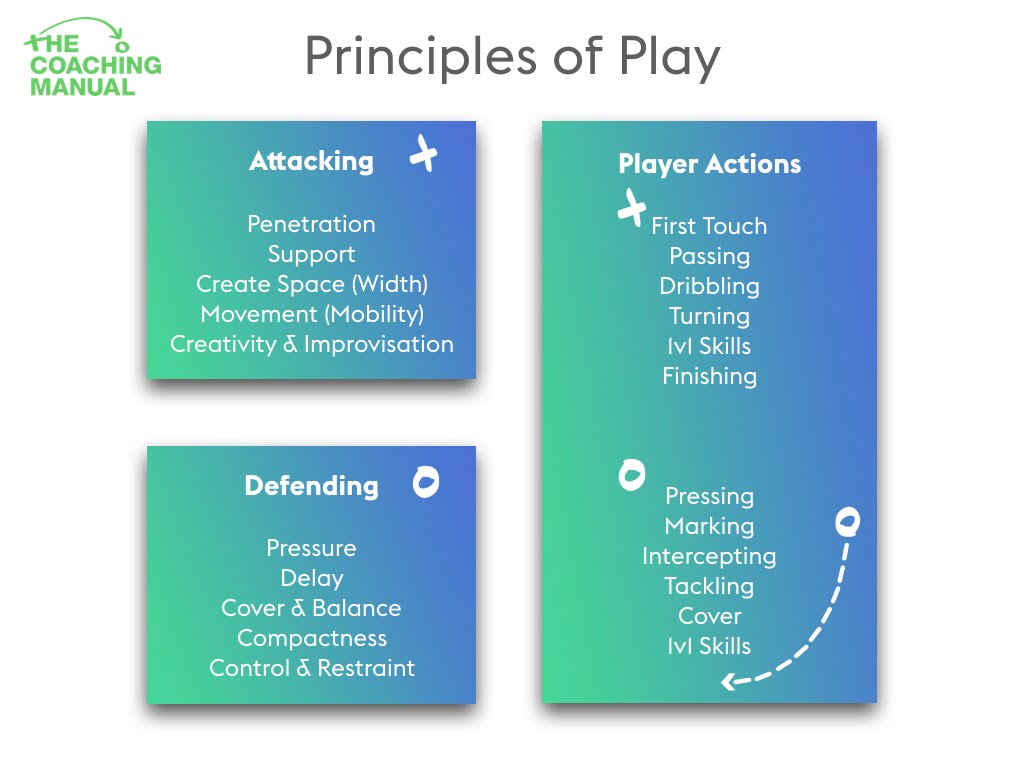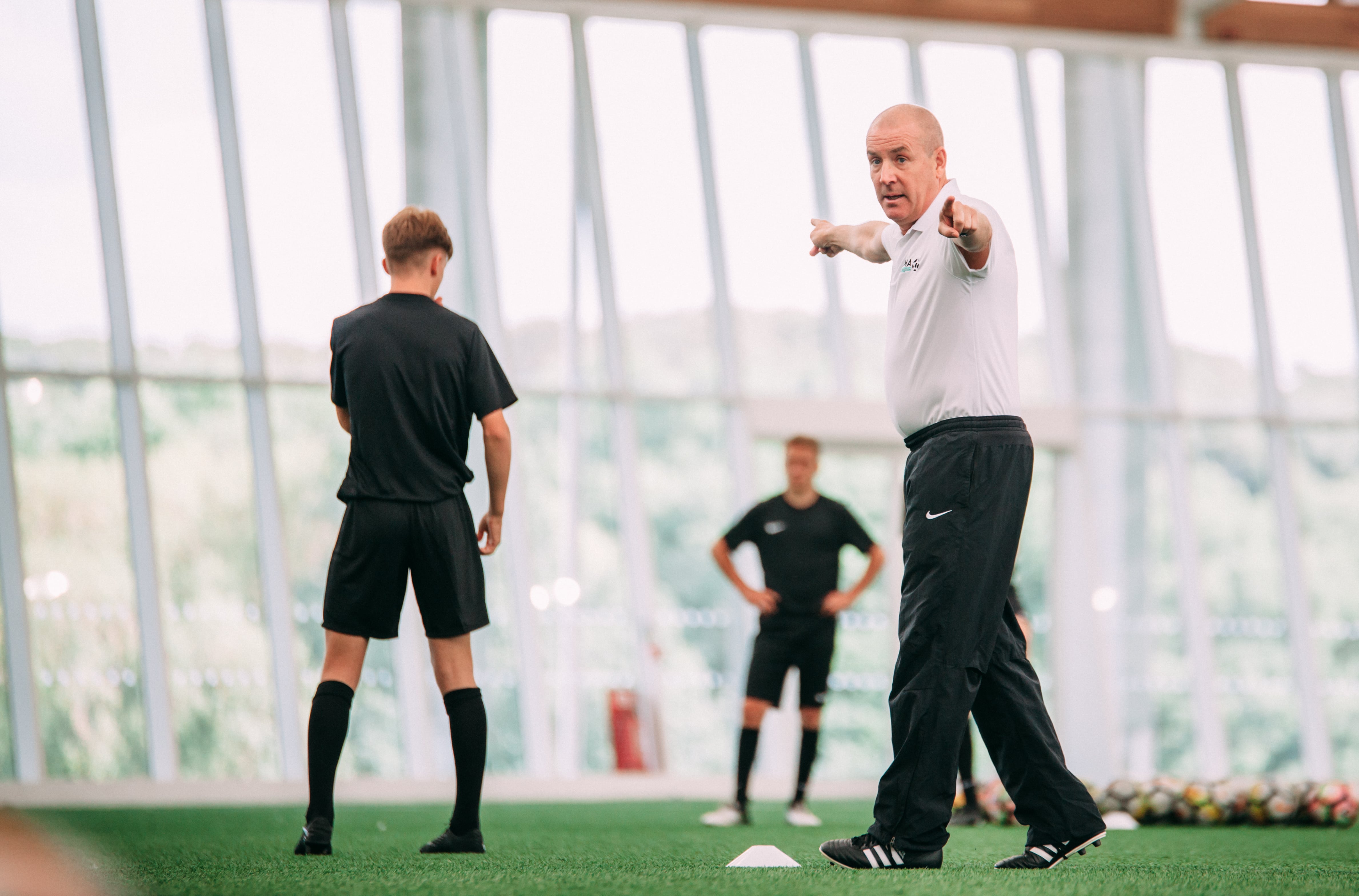Starting Point
As a professional coach, I have observed many games and identified development areas that I would like to work on with players the following week. I have also had the experience of working from club season plans and curriculums, devised in-line with the overall philosophy of the club, and have been given specific themes to work on each week.
Whether I am working from a curriculum or addressing individual and team development needs I always follow the same process when designing coaching sessions; I start with the 11v11 game and work backwards.
This involves looking at the overall game, highlighting what I would like the players to be able to achieve in the game and then breaking it down into practices that will facilitate repetition and learning of the chosen development area.
As players begin to understand and perform the session outcomes, I direct the practice back towards the game, albeit with conditions that may continue to promote the theme.
Practice Design Considerations
When planning a session there are a number of considerations I look to address in order to ensure that football is being played, coached and learned.
1. Direction - Football is an invasion game that involves a team attacking one goal line and defending the opposite goal line. Wherever possible, I include a directional element to my practices so that the attacking and defending principles of play can be adhered to. This makes the practice game-specific.
This directional practice by former England U20 Assistant Manager Paul Williams encourages players to make forward runs to create attacking overloads.
2. Goals - As players partake in the practice I communicate the established and set goals for all to achieve. This may involve scoring, passing to a target player, dribbling across a line or accumulating X number of passes. The goal should be directly linked to the theme of the session.

Also, if my session is focused on attacking principles, I set objectives for the defending team to achieve in order to keep them motivated, playing realistically and provided with rewarding incentives. The same goes for attacking players when coaching defending principles.
3. Repetition - As football is an open-ended sport in which there are many decisions for players to make to achieve specific outcomes. Within my planning, I attempt to ensure that the practice involves lots of repetition so players can be repeatedly exposed to game-specific cues and triggers in order to recognise and rehearse these "pictures" and apply them in the 11v11 game.
Small-sided practices will increase repetitions and decisions for players before additional players are added to connect units and build the learning towards the full-sided game.
4. Area size - The size of the playing area will also influence the outcomes of any practice and add or decrease the level of difficulty, dependent on the theme. For example, a small narrow pitch to develop combination play in the midfield third will provide more different challenges to the team in possession than the same practice delivered on a wide large pitch.

There are occasions when I am required to coach on a third or even a quarter of a full size pitch and I have to take this into consideration when structuring my practices and establishing outcomes for the session.
5. Player allocation - When coaching a specific theme it is important that key players/positions are involved with the practices. For example, in a session focusing on " rotation in the midfield third " I would involve the #6, 8 and 10 as well as the opposition midfield to provide pressure. Additional players such as defenders (to provide the forward pass) and attackers (to be a target to receive from midfield) may also be added.
Also, the distribution of players on each team can create overload or underload situations along with different challenges. This " defending out of balance 4v5 " session puts the defenders in underloaded situations to defend outnumbered.
The 5 W"s
When completing my USSF B Licence earlier this year I came across the 5 W's.
The 5 W"s (What, Who, Where, When and Why?) are questions that can be asked when solving problems or gathering information, and the United States Soccer Federation have implemented these questions into their coach education programs in order to facilitate effective game observations, analysis and session planning outcomes from their candidates.

When contemplating what to plan in my coaching sessions, I adopt the 5 W"s and find they provide clarity and guidance on the outcomes I want my players to achieve, as well as influencing my session design.
Below, I have reviewed each of the 5 W's and how I use this questioning process to support my development of planning game-specific sessions.
What? (Principles of play)
First proposed by Allen Wade in "The FA"s Guide to training and Coaching" in 1967, the attacking and defensive principles provide a framework for a team to focus their tactical strategies upon, and it is proposed that every practice and match depends on the successful execution of these principles.

The "what" links to the principles of play and, as the coach, I identify the specific outcome of the session and what I would like the team/unit/individuals to improve, for example “pressing to recover the ball back within 6 seconds.”
Who? (Unit Focus)
The targets and learning outcomes need to integrate the key players to achieve the outcomes. Furthermore, my key players need to be connected to their unit, and the units need to be connected to the team as the session progresses.
This develops communication and understanding within my team and clarifies roles of specific players when executing an objective in the game.
Where? (Area of the pitch)
Where possible, my practices are delivered in the area of the pitch where they occur within the game. For example, this practice on " playing out from the back " was delivered in the defensive third/half so that my players had visual references from the goal and penalty area that they can then transfer into the game.
When? (Phase of the Game)
In football, there are widely accepted to be four phases of the game; attacking, defending, transition to attack and transition to defend.
When planning a session it is important I recognise when the theme takes place in the game, as this will allow for successful recreation and implementation of the theme within practices.
Conditions may also have to replicate the timing, for example when working with a team on counter attacking, I would condition the opposition team to create a chance at goal within 5 passes. This will encourage the opposition to attack quickly and when possession is lost and transition occurs, I could focus on observing and coaching the counter attack.
Why? (Game Understanding and Decision Making)
In my personal opinion, this is possibly the most important question to ask when planning a session for your players. I believe that being able to answer why a particular component of the game is/isn't happening demonstrates sound observational skills and game understanding, and should directly influence the key outcomes of the session.

Furthermore, it is vital that my players within the session also understand why they are working towards these set objectives, where they occur within the game and in their particular roles. Players on the pitch ultimately make decisions and execute game plans and understanding why will inform this mental process and increase the tactical awareness of the team.
When I sit down and plan what to include within a coaching session, there are a number of practice design considerations to take into account to ensure that the session looks and feels like the real game.
This includes planning to have a directional element, ensuring goals are set for all players, deciding on player numbers, allocations (overloads/underloads), replicating the area of the pitch where the theme occurs and providing opportunities for repetition and touches of the ball.
Additionally, I also utilize the 5 W's to guide my planning process and create learning outcomes that address individuals, units and the team in specific phases of the game.

![What To Plan In A Coaching Session [Part 3]](https://content.thecoachingmanual.com/hubfs/what%20to%20plan%20in%20a%20coaching%20session-min.jpg)
